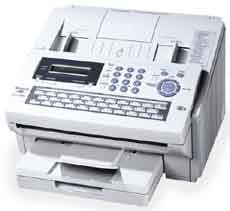Fax Machines Information

Fax machines (short for facsimile machines) send and receive documents that are transmitted as a stream of audio data over a telephone line. The sending machine scans a hard-copy document to create a facsimile (fax), which the receiving machine then prints. Typically, the printing mechanism is a laser or ink jet; however, some older fax machines use thermal paper. When selecting products, buyers should consider the speed of transmission. Fax machine features include scanners, email, and color printing.
History
Fax machines have existed in one form or another since the mid-nineteenth century. The first successful fax tranmission was performed by Scottish inventor Alexander Bain. Between 1843-1846, Bain developed a machine using technology from clocks and telegraph machines. His invention used an electric probe mounted to a pendulum to detect images on the metal surface of a graphic sign. The probe transmitted pulses to another machine that reproduced the image on electochemically sensitive paper. Although successful, the reproduced images were of poor quality.
Many other inventors followed Bain's early work, including:
- Giovanni Caselli, an Italian physicist, developed a pantelegraph machine that successfully transmitted a fax between Paris and London.
- Earnest Hummel, an American watchmaker, developed a machine called a Telediagraph in 1895.
- Dr. Arthur Korn developed the first practical fax machine, referred to as the photoelectric system in 1902 for tranmitting photographs. He sent the first fax between two cities in 1907, when he transmitted a photograph from Munich to Berlin.
- American Telephone & Telegraph Company (AT&T) developed a telephotography machine between 1920-1923 that was used to send political pictures from conventions in several US cities in 1924.
- Alexander Muirhead, a Scottish electrical engineer, developed a successful fax machine in 1947.
- Xerox Corporation made significant advancements in the mid 1960s, developing a machine that could be connected to any telephone line.
-
Japanese coporations made signifcant enhancements in the 1970s that resulted in smaller, faster, and more efficient fax machines.
Operation
Modern fax machines digitally scan printed textual and graphical information, convert the scan to audio-frequency tones and transmit the tones over telephone lines. When the fax is received, the fax machine interprets the tones, converts them to reconstruct the original message, and prints them.
Most home and office fax machines use a charge coupled device (CCD) image sensor during imaging scanning to transform a light pattern into an electric charge pattern (electronic image). CCD image sensors may be color or monochrome (black and white). During document scanning, light is reflected off of each pixel and converted to and electronic signal. The resulting charge pattern is converted to binary digits, compressed, and then converted to an analog carrier wave and transmitted over the telephone line via a modem. The fax on the receiving end receives the carrier wave, decodes it, and sends it to a printer.
Standards
Since 1980, fax machines are designed to conform to Group 3 or Group 4 fax protocols. Group 1 and Group 2 protocols were developed for analog signal transmission.
Group 3 covers digital fax transmission and is specified by the following International Telecommunications Union (ITU) standards:
-
ITU-T T.30 -- Procedures for Document Facsimile Transmission in the General Switched Telephone Network
-
ITU-T T.4 -- Standardization of Group 3 Facsimile Apparatus for Document Transmission
-
ITU-T T.6 -- Facsimile Coding Schemes and Coding Control Functions for Group 4 Facsimile Apparatus
Group 4 covers fax machines designed to operate over 64 kbit.s digital ISDN circuits. Standards defining the Group 4 protocol include:
-
ITU-T T.563 -- Terminal Characteristics for Group 4 Facsimile Apparatus
-
ITU-T T.503 -- Document Application Profile for the Interchange of Group 4 Facsimile Documents Series T
-
ITU-T T.521 -- Communication Application Profile BT0 for Document Bulk Transfer Based on the Session Service
-
ITU-T T.6 -- Facsimile Coding Schemes and Coding Control Functions for Group 4 Facsimile Apparatus
-
ITU-T T.62 -- Control Procedures for Teletex and Group 4 Facsimile Services
-
ITU-T T.70 -- Network-Independent Basic Transport Service for the Telematic Services
-
ITU-T T.411 -- Information Technology: Open Document Architecture (ODA) and Interchange Format—Introduction and General Principles
-
ITU-T T.417 -- Information Technology: Open Document Architecture (ODA) and Interchange Format—Raster Graphics Content Architectures



